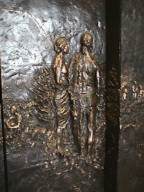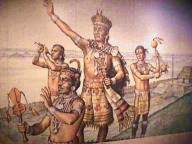Cahokia
Mounds
North
America's Pre-historic Culture
Collinsville,
IL
April 5, 2000
While  spending a week in St. Louis, Laura searched
around for a possible story and found something most unusual, at
least to me. Although never having traveled to the part of Mexico
where the great pyramids are, I have always pictured these great
structures as part of an ancient Mexican Indian culture. I was
quite surprised when we came across one of the great mounds in
Illinois. The Cahokia Indians created a city of some 20,000
people beginning around 700 AD, and at one point they created an
earthen mound the size of a pyramid. The Cahokia Mounds State
Historic Site which is also a World Heritage Site, is a 2,200
acre site preserving the central section of the largest
prehistoric Indian city north of Mexico. The 65 man-made earthen
mounds, wooden sun calendar and Interpretive Center presents an
account of the sophisticated culture whose city was centered
here. The 33,000 square foot
spending a week in St. Louis, Laura searched
around for a possible story and found something most unusual, at
least to me. Although never having traveled to the part of Mexico
where the great pyramids are, I have always pictured these great
structures as part of an ancient Mexican Indian culture. I was
quite surprised when we came across one of the great mounds in
Illinois. The Cahokia Indians created a city of some 20,000
people beginning around 700 AD, and at one point they created an
earthen mound the size of a pyramid. The Cahokia Mounds State
Historic Site which is also a World Heritage Site, is a 2,200
acre site preserving the central section of the largest
prehistoric Indian city north of Mexico. The 65 man-made earthen
mounds, wooden sun calendar and Interpretive Center presents an
account of the sophisticated culture whose city was centered
here. The 33,000 square foot  Interpretive Center who's metal clad front doors
are covered with a bas-relief that tempts one to come in,
explains in great detail, the almost 1000 year history of Indian
life at the convergence of the Mississippi and Missouri rivers.
The flood plains of these rivers provided rich soil, abundant
plant and animal life, and access to an enormous trade network.
Pre-Columbian cultures developed and flourished here for several
hundred years before vanishing sometime after the 14th century.
The loosely connected villages gradually condensed. The first
organized culture probably emerged in the late woodland period,
somewhere around 700 A.D. Very little is known of these first
dwellers, as they centered in small compact villages. They were
hunters and fishermen, leaving little behind
Interpretive Center who's metal clad front doors
are covered with a bas-relief that tempts one to come in,
explains in great detail, the almost 1000 year history of Indian
life at the convergence of the Mississippi and Missouri rivers.
The flood plains of these rivers provided rich soil, abundant
plant and animal life, and access to an enormous trade network.
Pre-Columbian cultures developed and flourished here for several
hundred years before vanishing sometime after the 14th century.
The loosely connected villages gradually condensed. The first
organized culture probably emerged in the late woodland period,
somewhere around 700 A.D. Very little is known of these first
dwellers, as they centered in small compact villages. They were
hunters and fishermen, leaving little behind  to mark their
existence. A second, more sophisticated culture, the
Mississippian culture, emerged between 850 and 900 A.D. Rather
than being a completely different Indian group, the
Mississippians were probably descendants of the late Woodland
people. Differences between the two cultures are explained by the
gradual integration of new ideas and technologies which among
other things allowed the Mississippians to develop a more
extensive agricultural system which included corn and squash as
the principle cultivated crop. Sustained by a staple food base
and bountiful hunting and fishing, the Mississippians built a
complex community with a highly specialized social, political and
religious organization. The prehistoric city that we call Cahokia
became the regional center of that culture. Cahokia was governed
by a Chief claiming divine power. Called "Great Sun" in
later Mississippian cultures, the Chief was thought to be the
brother of the solar sun. Under the Chief were high ranking
relatives, sub-chieftains and an elite class. From there, power
spread downward to the heads of clans that controlled
to mark their
existence. A second, more sophisticated culture, the
Mississippian culture, emerged between 850 and 900 A.D. Rather
than being a completely different Indian group, the
Mississippians were probably descendants of the late Woodland
people. Differences between the two cultures are explained by the
gradual integration of new ideas and technologies which among
other things allowed the Mississippians to develop a more
extensive agricultural system which included corn and squash as
the principle cultivated crop. Sustained by a staple food base
and bountiful hunting and fishing, the Mississippians built a
complex community with a highly specialized social, political and
religious organization. The prehistoric city that we call Cahokia
became the regional center of that culture. Cahokia was governed
by a Chief claiming divine power. Called "Great Sun" in
later Mississippian cultures, the Chief was thought to be the
brother of the solar sun. Under the Chief were high ranking
relatives, sub-chieftains and an elite class. From there, power
spread downward to the heads of clans that controlled  the
general population. Cahokia was an urban center, with a large
central population and support settlements. Major U.S. cities
today are generally regarded as urban areas if their populations
exceed 250 people per square mile. There were 4000 people per
square mile at Cahokia. The dense population created what is now
is called urban stress. Symptoms of urban stress at Cahokia
included malnutrition, increased exposure to disease, pollution
from wood fuel and human and animal waste, and the depletion of
natural resources. Cahokia was one of the biggest cities in the
world around 1250 A.D. At the height of its existence, Cahokia
had a population of over 20,000 people. Around 1100 A. D. the
the
general population. Cahokia was an urban center, with a large
central population and support settlements. Major U.S. cities
today are generally regarded as urban areas if their populations
exceed 250 people per square mile. There were 4000 people per
square mile at Cahokia. The dense population created what is now
is called urban stress. Symptoms of urban stress at Cahokia
included malnutrition, increased exposure to disease, pollution
from wood fuel and human and animal waste, and the depletion of
natural resources. Cahokia was one of the biggest cities in the
world around 1250 A.D. At the height of its existence, Cahokia
had a population of over 20,000 people. Around 1100 A. D. the Mississippians built a wooden wall 12 to 15 feet high around 300
acres of the central city. Perhaps it served to protect the
central sacred area or to separate the social classes. Whatever
the purpose the wall was so important to the Indians that they
rebuilt it three times. Each reconstruction required 15,000
trees. The resulting depletion of the wood supply may have
contributed to the eventual disappearance of the Mississippians
from this area. The Mississippians were builders of earthen
mounds, sometimes similar in shape to the pyramid of other
Central American Indian cultures. They built as many as 120 of
these mounds in an area stretching as far away as St. Louis. Many
have been altered or destroyed by modern farming and urban
development. Of those that survived, approximately 65 are
preserved within the boundaries of this historic site. Though a
few of the mounds were used for burials, most were for ceremonial
activities for the living. The mounds are made entirely from dirt
dug with tools of stone, wood or shell, and transported on
people's backs in baskets to the mound site. The digging left
large depressions called borrow pits, which can still be
Mississippians built a wooden wall 12 to 15 feet high around 300
acres of the central city. Perhaps it served to protect the
central sacred area or to separate the social classes. Whatever
the purpose the wall was so important to the Indians that they
rebuilt it three times. Each reconstruction required 15,000
trees. The resulting depletion of the wood supply may have
contributed to the eventual disappearance of the Mississippians
from this area. The Mississippians were builders of earthen
mounds, sometimes similar in shape to the pyramid of other
Central American Indian cultures. They built as many as 120 of
these mounds in an area stretching as far away as St. Louis. Many
have been altered or destroyed by modern farming and urban
development. Of those that survived, approximately 65 are
preserved within the boundaries of this historic site. Though a
few of the mounds were used for burials, most were for ceremonial
activities for the living. The mounds are made entirely from dirt
dug with tools of stone, wood or shell, and transported on
people's backs in baskets to the mound site. The digging left
large depressions called borrow pits, which can still be seen. Most mounds were built in several stages. It is estimated
that the Indians moved more then 50 millions cubic feet of earth
for mound construction with almost half of it going into one
mound. Mounds were built in platform, conical and ridge-top
formations. Platform mounds usually served as bases for buildings
for ceremonial or religious uses or residences for rulers and
priests. Monks Mound is the most commanding mound and is the
largest prehistoric earthen construction in the New World. This
100 foot tall four-tiered platform was built in stages over a
period of 300 years. Its base covers more then 14 acres, and it
contains about 22 million cubic feet of earth. A massive building
105 feet long by 48 feet wide and 50 feet high once stood at the
top. Here the Indians' principal ruler lived,
seen. Most mounds were built in several stages. It is estimated
that the Indians moved more then 50 millions cubic feet of earth
for mound construction with almost half of it going into one
mound. Mounds were built in platform, conical and ridge-top
formations. Platform mounds usually served as bases for buildings
for ceremonial or religious uses or residences for rulers and
priests. Monks Mound is the most commanding mound and is the
largest prehistoric earthen construction in the New World. This
100 foot tall four-tiered platform was built in stages over a
period of 300 years. Its base covers more then 14 acres, and it
contains about 22 million cubic feet of earth. A massive building
105 feet long by 48 feet wide and 50 feet high once stood at the
top. Here the Indians' principal ruler lived,  conducted
ceremonies and governed the city below. Running up the almost 150
steps, broken up by 16 landings was a grueling exercise but the
view from the top was spectacular. Imagining looking down on the
activities of some 20,000 people and the line of basket carriers
stretching out for miles, was something to experience. This was a
great outing and a perfect way to get some much needed exercise.
Sometime around the 15th century, a slow steady decline in
population occurred, as it is presumed the land simply could no
longer provide for the people. With it being many centuries
before fertilizers would be introduced, the one or two staples
repeatedly planted on the same patch of land, finally drained the
soil of its needed nourishment, and cleared land was no longer
able to protect the game previously abundant everywhere.
Eventually, hunger and disease reduced this great city to its
final ghost town stage. Too much of a good thing had finally
brought down the most sophisticated culture, to date, in North
America. I went away hearing the pre-historic warnings offered
and wondering what had we learned in a thousand years. For
further information check their website at: http://www.cahokiamounds.com.
conducted
ceremonies and governed the city below. Running up the almost 150
steps, broken up by 16 landings was a grueling exercise but the
view from the top was spectacular. Imagining looking down on the
activities of some 20,000 people and the line of basket carriers
stretching out for miles, was something to experience. This was a
great outing and a perfect way to get some much needed exercise.
Sometime around the 15th century, a slow steady decline in
population occurred, as it is presumed the land simply could no
longer provide for the people. With it being many centuries
before fertilizers would be introduced, the one or two staples
repeatedly planted on the same patch of land, finally drained the
soil of its needed nourishment, and cleared land was no longer
able to protect the game previously abundant everywhere.
Eventually, hunger and disease reduced this great city to its
final ghost town stage. Too much of a good thing had finally
brought down the most sophisticated culture, to date, in North
America. I went away hearing the pre-historic warnings offered
and wondering what had we learned in a thousand years. For
further information check their website at: http://www.cahokiamounds.com.
*** THE END ***
